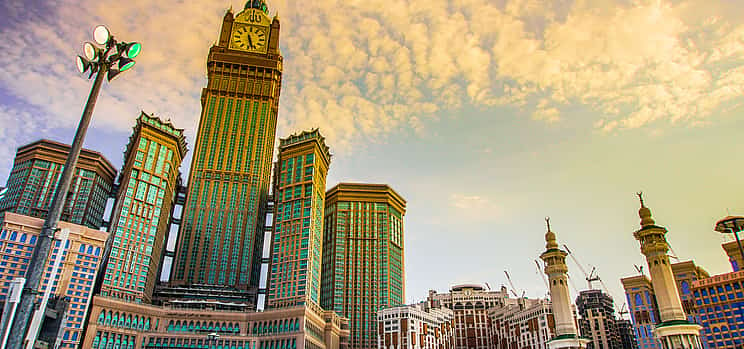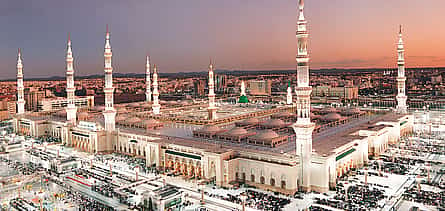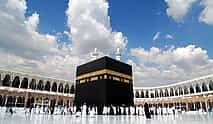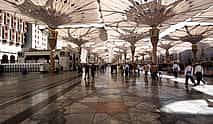Makkah is one of the most beautiful and modern cities in the world. Each landmark continues spiritual and deep history for Muslims. With your driver-guide, you will explore the iconic sites in just a few hours.
Highlights:
- Visit the Holiest city in the Islam religion, Mecca Saudi Arabia
- Discover all of the historic sites in just a few hours
- Visit the Great Mosque, the Kaaba, Mount Arafat, and many other holy sites
- Learn about the history of the Prophet Mohamed, Sahab's, Islamic History, the Hajj pilgrimage
- Private Air-conditioned vehicle (Toyota Hiace or similar)
- English Speaking Driver Guide
Not Included:
- Food and Drinks
- Personal Expenses
- Entrance fee
Please note: We pick up all tourists / Umrah Piligrams from their respective hotels within the Makkah (Mecca) City area.
Makkah is a city in the Hejazi region of Saudi Arabia. The city is located 70 km inland from Jeddah, 340 kilometers south of Medina. It is the birthplace of our Profit Muhammad (PBUH). Makkah is home to the Kaaba, one of Islam's holiest sites and the direction of Muslim prayer, and thus Makkah is regarded as the holiest city in Islam. In this 2-3 hours tour, we will cover all the Holy places of Makkah starting from Masjid-e-Nimra
The Kaaba, a pre-Islamic monument, rededicated by Muhammad in 631-32 C.E., multiple renovations, granite masonry, covered with silk curtain and calligraphy in gold and silver-wrapped thread (Mecca, Saudi Arabia) Image credit: The Kaaba in the Masjid el Haram, 2010 Tab59, CC BY-SA 2.0. Pilgrimage to a holy site is a core principle of almost all faiths. The Kaaba, Located in Mecca, Saudi Arabia, is the holiest shrine in Islam. In Islam, Muslims pray five times a day, and after 624 CE, these prayers were directed towards Mecca and the Kaaba rather than Jerusalem; this directionor qibla in Arabicis marked in all mosques and enables the faithful to know in which direction they should pray. The Quran established the direction of prayer. All Muslims aspire to undertake the hajj, or the annual pilgrimage, to the Kaaba once in their lives if they are able. Prayer five times a day and the hajj are two of the five pillars of Islam, the most fundamental principles of the faith.
The Great Mosque of Mecca, commonly known as the al-Masjid al-Ḥarām, is a mosque that surrounds the Kaaba in the city of Mecca, in the Hejazi region of Saudi Arabia.
Safa and Marwa are two small hills now located in the Great Mosque of Mecca, in the Hejazi region of Saudi Arabia. Muslims travel back and forth between them seven times, during the ritual pilgrimages of Ḥajj and ʿUmrah.
The Hajar al-Aswad (The Black Stone), which is set in the eastern corner of the Kabah. Tawaf begins and ends facing this sacred stone. Throughout the ages, countless people including many of the Prophets (upon them be peace), the Prophet Muhammad (ﷺ) himself, the Sahabah (may Allah be pleased with them), pious personalities and millions of Muslims who have performed Hajj and Umrah have placed their blessed lips on it.
The Maqame Ebrahim refers to the stone on which Ebrahim (upon him be peace) stood on while he was building the Kabah. As Ismail (upon him be peace) passed stones to Ebrahim (upon him be peace), and as Ebrahim (upon him be peace) continued laying them in place the Maqame Ebrahim miraculously continued rising higher and higher as the walls rose. Allah (ﷻ) caused the trace of his footprints to remain on the stone as a reminder to the believers among his descendants.
Mina, seven kilometers east of the Masjid al-Haram is where Hajj pilgrims sleep overnight on the 8th, 11th, 12th (and some even on the 13th) of Dhul Hijjah. It contains the Jamarat, the three stone pillars which are pelted by pilgrims as part of the rituals of Hajj.
The masjid above is Masjid Nimrah and is located on the plain of Arafat. When the Prophet (ﷺ) was at Arafat on his farewell Hajj on the ninth day of Dhul Hijjah 10 AH (632 CE) he camped here. After midday, he delivered his famous sermon (reproduced below) at Waadi Urana nearby while seated on his camel, after which he led the salah. More than 100,000 Sahabah accompanied him on this Hajj.
Also known as Jabal-Ar-Rahmah or the Mount of Mercy, Mount Arafat is a hill in the valley of Arafat outside Makkah where Prophet (pbuh) gave his last sermon after completing Hajj. It is mandatory for pilgrims to leave Mina and reach Mount Arafat on 9th Dhual Hijjah and spend the day praying, doing Dhikr and asking for forgiveness from Allah (SWT). Standing in Arafat is an essential part of Hajj and it is considered invalid if a pilgrim fails to reach here.
Muzdalifah is an open, level area near Mecca in the Hejazi region of Saudi Arabia that is associated with the Ḥajj ("Pilgrimage"). It lies just southeast of Mina, on the route between Mina and Arafat. The stay at Muzdalifah is preceded by a day at Arafat, consisting of glorifying Allāh repeating the Dua, repentance to Allah, and asking Him for forgiveness. At Arafat, Ẓuhr and ʿAṣr prayers are performed in a combined and abbreviated form during the time of Zuhr. After sunset on the ninth day of the Islamic month of Dhūl-Ḥijjah, Muslim pilgrims travel to Muzdalifah, sometimes arriving at night because of over-crowding. After arriving at Muzdalifah, pilgrims pray the Maghrib and ʿIshāʾ prayers jointly, whereas the Isha prayer is shortened to 2 rakats.
Mount Thawr (or Jabal Thawr) is the mountain that contains the cave in which the Prophet (ﷺ) and Abu Bakr (may Allah be pleased with him) sought refuge for three days and nights from the Quraysh, as they left Makkah and emigrated to Madinah. After Jabal Thawar our Last Attraction will be Canal Sakeena.
Mount Hira (Jabal Hira), which lies about two miles from the Kabah. Near the top is a small cave, a little less than 4 meters in length and a little more than one and a half meters in width. It was here that the Prophet Muhammad (ﷺ) received the first revelations of the Holy Quran during the month of Ramadhan in 610 CE. The mountain is also known as Jabal Noor (the Mountain of Light).
Masjid Jinn, also known as Masjid Haras, is built on the place where the Prophet (ﷺ) drew a line for Abdullah bin Masood (may Allah be pleased with him) who had accompanied him after he had been commanded to recite the Quran to the Jinn. After Masjid Jinn our guide will go towards Masjid-e- Shajar, Masjid-e-Qamar, Jannat-al-Moulla.
In the end, our driver will drop you at your selected location within Makkah City



